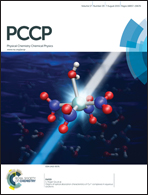Which charge definition for describing the crystal polarizing field and the χ(1) and χ(2) of organic crystals?†
Abstract
The impact of atomic charge definition for describing the crystal polarizing electric field has been assessed in view of predicting the linear and nonlinear optical susceptibilities of molecular crystals. In this approach, the chromophores are embedded in the electric field of its own point charges, which are evaluated through a self-consistent procedure including charge scaling to account for the screening of the dielectric. Once the crystal field is determined, dressed molecular polarizabilities and hyperpolarizabilities are calculated and used as input of an electrostatic interaction scheme to evaluate the crystal linear and nonlinear optical responses. It is observed that many charge definitions (i) based on partitioning the electron density (QTAIM), (ii) obtained by analyzing the quantum-chemical wavefunction (Mulliken, MBS, and NBO), and (iii) derived by fitting to the electrostatic potential (MK, CHelpG, and HLYGAt) give very consistent results and are equally valid whereas Hirshfeld partitioning and CM5 charge parametrizations underestimate the refractive indices and second-order nonlinear optical susceptibilities. An alternative approach omitting charge scaling is demonstrated to overestimate the different crystal optical properties. On the other hand, the molecule embedding approach provides results in close agreement with those calculated with a charge field obtained from periodic boundary condition calculations.



 Please wait while we load your content...
Please wait while we load your content...